New South Wales is an Australian state that’s on the east coast. When it comes to water in the area, most people tend to think about beaches first. However, there are all sorts of lakes throughout New South Wales as well. Some of them make for the perfect spots to soak up some sun. Or, if you’re into water sports, you can find several that offer a place to boat, swim, kayak, or paddle board. When you visit the cleanest lakes in New South Wales, you leave feeling relaxed.
Unfortunately, not all of the lakes in New South Wales are clean. Some have nasty run-off while others may be susceptible to algal blooms. You don’t want to have a fun day on the water only to head home feeling sick or getting a rash.
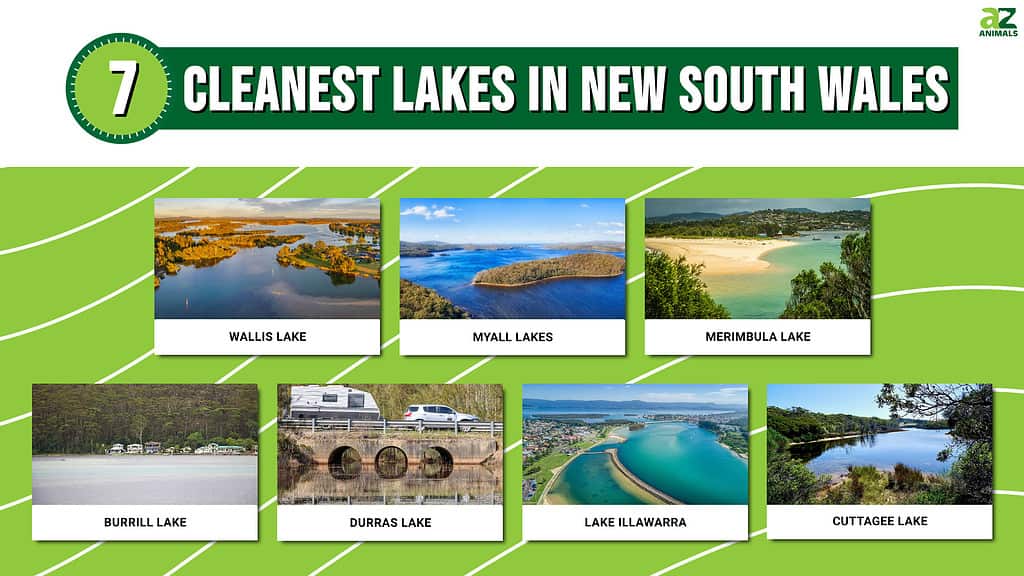
To learn more about the seven cleanest lakes in New South Wales, read below.
How Many Lakes Are in New South Wales?
There’s no exact number of total lakes in New South Wales, Australia. There are an estimated 135 bodies of water that drain into the sea. This includes a mix of lakes, creeks, rivers, lagoons, and inlets. Of all of these 90 of them are lagoons or lakes that measure bigger than two and a half acres or one hectare.
Most of the lakes mentioned in the article below are estuaries. Estuaries play a vital role in local animal and plant life. Animals that live in the sea, and animals that stay in rivers tend to depend on this unique mix of water.
Because many of the animals are endangered or threatened, local scientists and the government work hard to make sure these bodies of water stay as clean as they can possibly be. Many tourists help to fund the area when they come to visit and play in the waters, which means more money goes to keeping these bodies of water protected.
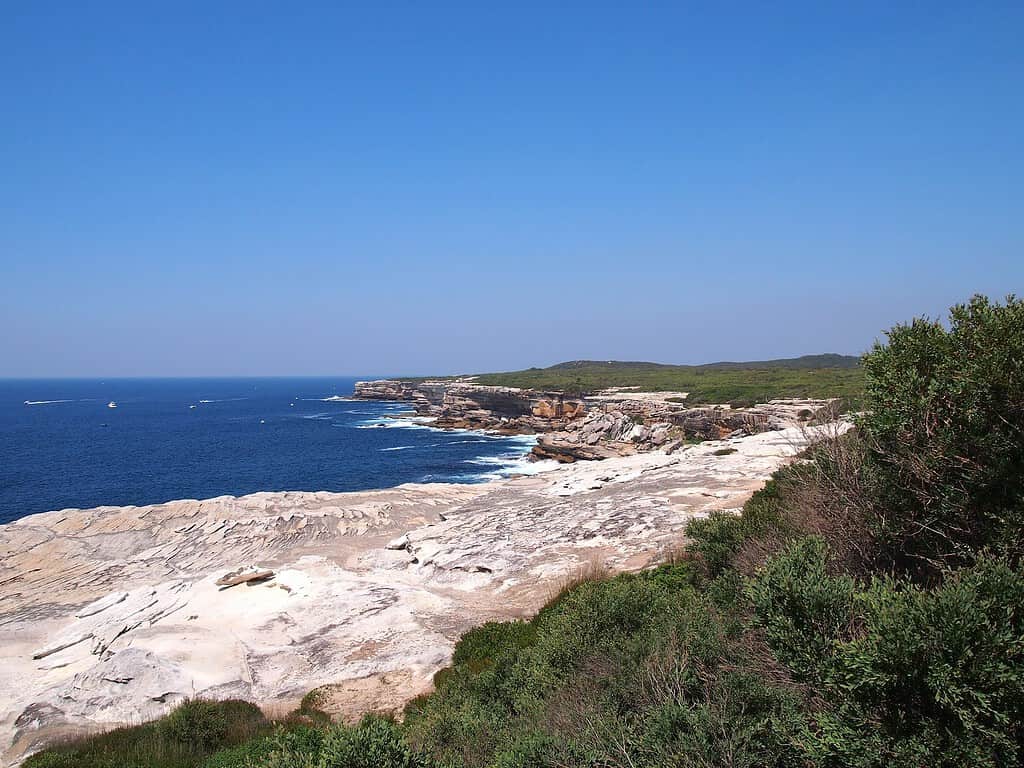
The beaches are what New South Wales is known for, but that isn’t the only water worth visiting.
©Maurice van Creij / CC BY 3.0 – License
What Are the Main Causes of Pollution in Lakes Around New South Wales
Rainfall run-off is likely the main cause of poor water quality in all lakes throughout New South Wales. It causes a lot of problems. As the rain falls, it picks up pollutants and trash.
Then, it carries these pollutants to the nearest body of water. Or, it takes the pollutants and drags them into the groundwater as it absorbs into the earth. This groundwater then goes on to feed rivers and lakes throughout New South Wales.
This is a huge problem because it isn’t something easily preventable. Rain picks up everything from untreated sewage pollutants to fertilizers and chemicals sitting on top of asphalt, which isn’t easy to keep clean at all. When these pollutants enter the water, they can cause algal blooms.
Algal Blooms
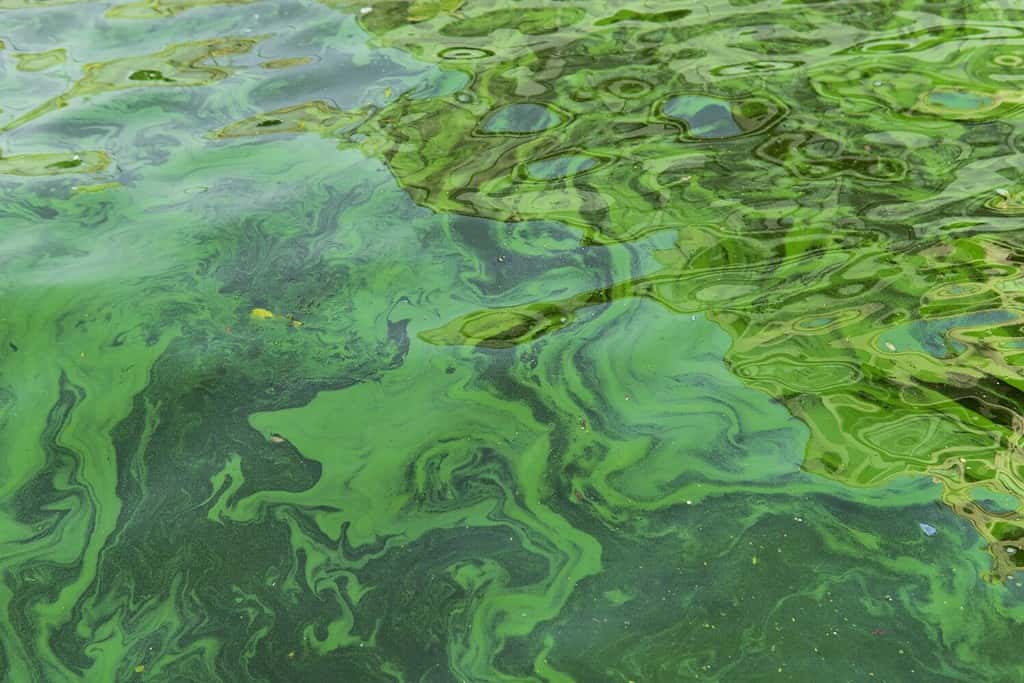
When an excess of nitrogen gets into the water, it causes an algal bloom.
©Aleksandrkozak/Shutterstock.com
While all of the pollutants are already quite gross when they enter a lake, it’s specifically the untreated sewage and fertilizers that cause the biggest problems. These pollutants are high in nitrogen. When an excess of nitrogen gets into the water, it causes an algal bloom.
These algal blooms cause huge health issues to people who swim through them. Interestingly, though they are called algal blooms, they are actually a type of bacteria or cyanobacteria. These bacteria are a critical part of the environment but if they get too many nutrients, they can become a danger to everything that uses the water.
When people expose themselves to a lot of blue-green algae, they may experience symptoms such as allergic reactions, difficulty breathing, diarrhea, nausea, irritation, and vomiting. Pets and children may see the worst symptoms as they tend to ingest the water containing algae spores more than adults. Even if you decide to take a risk, you shouldn’t ever take pets or young children into water where blue-green algal blooms are a threat.
What to Do About Algal Blooms
New South Wales offers an algae alert map. While they don’t always manage to catch every outbreak, they try to have an up-to-date map of some of the algal blooms and the bacteria levels at each lake.
It’s a great website to check before heading out for a day on the water. They also suggest staying away from any body of water near where it has rained for three days. This helps give the algal bloom time to die off and for the bacteria to go back down to normal levels.
Even for the cleanest lakes, such as those on this list, having rainwater can lead to dangerous algal blooms. So no matter which lake you go to visit, it’s best to wait a few days after the last rain.
The Cleanest Lakes in New South Wales
Now that you understand the importance of searching for clean lakes to play in, it’s time to look at the cleanest lakes in the state.
1. Wallis Lake

Wallis Lake is an estuary lake located between Forster and Tuncurry.
©Merrillie Redden/Shutterstock.com
Not only is this one of the cleanest lakes in New South Wales, Wallis Lake boasts being one of the cleanest lakes in all of Australia. The water is clean and clear all year round.
Wallis Lake is one of the Great Lakes of New South Wales. It sits between Forster and Tuncurry, acting as a divide between them.
In the summer months, it is a hotbed of water sports including boating, fishing, swimming, and paddle boarding. In addition to people, there’s also a lot of wildlife in the water. It’s not uncommon to see a dolphin, ray, or turtle in the water swimming alongside people.
The towns around Wallis Lake boast some fresh seafood, especially oysters. The lake is the biggest producer of Sydney Rock Oysters in the area. It also produces 80% of the commercial crabs for the state.
The Lake itself is 15.5 miles (25 km) long and 5.5 miles (9 km) wide. It connects to the Wallamba River, Coolongolook River, Wang Wauk River, Wallingat River, and Pipers Creek. One of the reasons it manages to stay so clean is because there are national parks on either side. To the west is the Wallingat National Park, and to the left is Booti Booti National Park.
Standards are high for water quality in Wallis Lake because it’s an estuary. It’s the last line of defense before pollutants enter the ocean. It’s also home to a lot of young and rare wildlife that needs pristine water to grow.
2. Myall Lakes

The National Park known as Myall Lakes features several interconnected bodies of water.
©Taras Vyshnya/Shutterstock.com
Myall Lakes National Park hosts several lakes. There are three interconnected lakes. Therefore, they have very similar water quality. These are Myall Lake, Boolambayte Lake, and The Broadwater.
Myall Lake takes up 14,000 acres (5,800 hectares). Boolambayte Lake is 2,700 acres (1,100 hectares) in size. The Broadwater is 5,900 acres (2,400 hectares).
Almost the entirety of these three lakes are protected by Myall Lakes National Park. In between each lake is uninhabited coastal woodlands and isolated beaches. There was some mining and wood farming several decades ago, but those practices have died off.
They were not always clean lakes. The mining and timber industry played quite a bit of havoc on the local environment and water. However, they are coastal dune lakes. Coastal dune lakes are important because they are made to hold water, filter water, and host unique flora and fauna that might not exist anywhere else.
Each coastal dune lake is a little different. They’re fairly shallow, but they have a lot of importance for the surrounding ecosystems. This is why environmentalists push for their protection, and a lot of effort went into making these three lakes clean. Efforts paid off because these three lakes are now some of the cleanest in New South Wales.
There are plenty of opportunities to visit these lakes. Walk around them, go kayaking, or enjoy a day of fishing. If you look around hard enough, you might see some of the unique flora and fauna that environmentalists fought so hard to protect. You can find white-bellied sea eagles, brown-striped frogs, or the wonga wonga vine.
3. Merimbula Lake
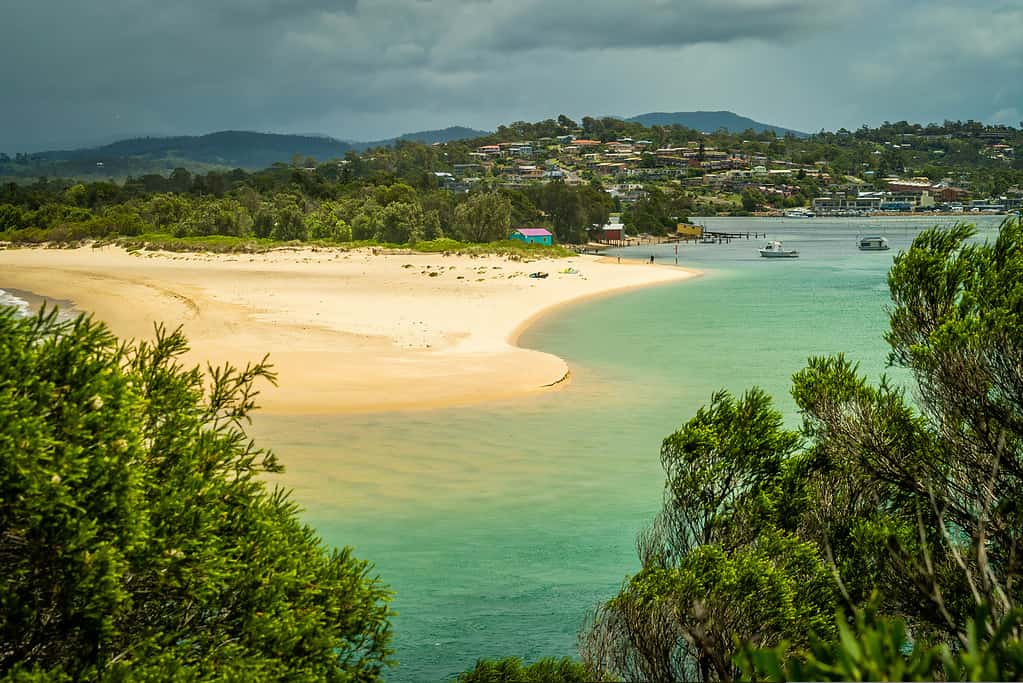
Merimbula Lake is full of stunning colors throughout the year.
©StephaneDebove/iStock via Getty Images
Merimbula Lake is one of the lakes that the New South Wales government checks frequently for water quality. Based on their latest report card, the algae rating, water clarity grade, and overall estuary health are all ranked an A. On this chart, an A is the same as ‘excellent’.
Merimbula Lake is on the Far South Coast. The lake is named after the town of Merimbula, which is a small area that has 3,544 people. The lake itself is both an inlet and an estuary. This makes it a very important lake that has a lot of unique habitats for local wildlife.
This means that Merimbula Lake is one of the cleanest lakes out there. This is good news because Merimbula Lake is popular for many reasons. For one, the surrounding area contains a rich ecosystem. There are coastal salt marshes and seagrass beds in the area that host a wide variety of important species for the area.
That’s not the only reason Merimbula Lake is so important, however. In addition to hosting diverse wildlife, the lake is also a popular area for tourists and locals to hang out. The lake is a paradise for water sports enthusiasts. There are plenty of places to paddle board, fish, swim, kayak, and boat. There are also places to wander around and relax in the sun.
Beautiful sand beaches surround the entire lake Rentals for various boats and equipment sit on the sand. There are also restaurants with local food such as oysters. If you’re an avid fisher, you’ll be pleased to note that some of the most popular fish are available in the waters. You can easily find bream, whiting, and flatheads.
4. Burrill Lake

There are plenty of places to stay in and around Burrill Lake.
©Ogdum/iStock via Getty Images
Burrill Lake is another lake that has an excellent rating across all three tests. It’s an A for algae levels, water clarity, and estuary health.
The village, sharing the same name, is a popular destination for fishers. At the lake, there are all sorts of fish to catch. If you have a good day, you can catch and cook your fish right on the water.
On the bad fishing days, there’s a local fish and chip shop as well as other restaurants where you can eat fresh and local seafood. Let someone else cook the daily catch for you while you enjoy the view of the village and the crystal-clear water.
If fishing isn’t your sport of choice, don’t worry. There are plenty of other sports to try out. There’s waterskiing, sailing, canoeing, kayaking, and paddle boarding available as well.
Burrill Lake hosts the Milton Ulladulla subtropical rainforest, which is an endangered ecological community. In the past, humans cleared a lot of the area for agricultural development, which means the area is rather narrow.
It’s an important habitat to keep going, as some endangered species such as the grey-headed flying fox and powerful owl need this habitat to survive. Just a little ways away is Dolphin Point. As the name suggests, it’s a great area to sit and watch for whales and dolphins.
The area is no stranger to tourists. There are plenty of spaces to stay at the caravan parks, and lots of holiday homes to choose from if you decide you want to visit the lake and stay for a few days.
5. Durras Lake
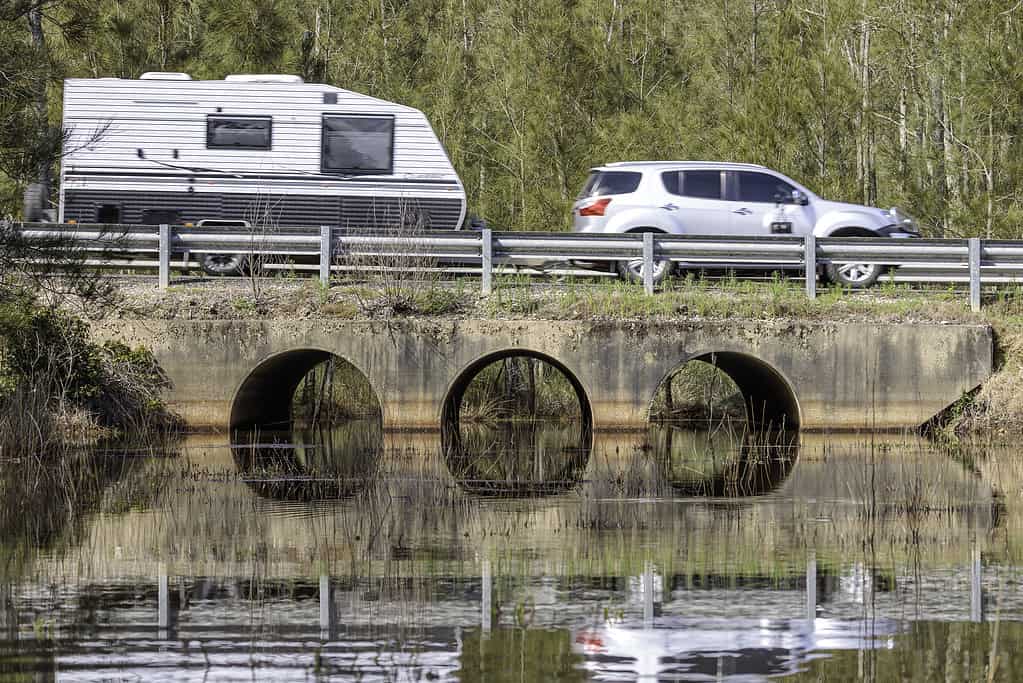
Parts of Murramarang National Park surround Durras Lake.
©Jonathan Steinbeck/iStock via Getty Images
Unfortunately, Durras Lake doesn’t have quite as good water quality as the other four lakes above it. While the algae levels are still an excellent (A) rating, the water clarity and estuary health are lower at a B rating. This is still a decent rating. After all, while B isn’t excellent, it does mean good.
The water quality has made vast improvements over the years. In previous years, it was common for one or more of the rankings to be at a C. It went through some particularly tough times between 2008 and 2013 when most of the rankings were a C, and some even were even as low as an E.
So while it’s not great, it’s comforting to know that the water quality is still quite good. The lake is now considered to be almost pristine, which is good news for some of the endangered ecological habitats such as the coastal salt marshes.
There are some sanctuary areas of the lakes where fishing and some other recreational activities aren’t allowed. However, for the most part, the area is open to fishing and other water sports such as kayaking, swimming, and crabbing.
The lake stretches out almost four miles in length (6 km), so there is plenty of water to explore. It has a few areas that branch off as well, to make for interesting places to visit that are a bit closed off.
6. Lake Illawarra
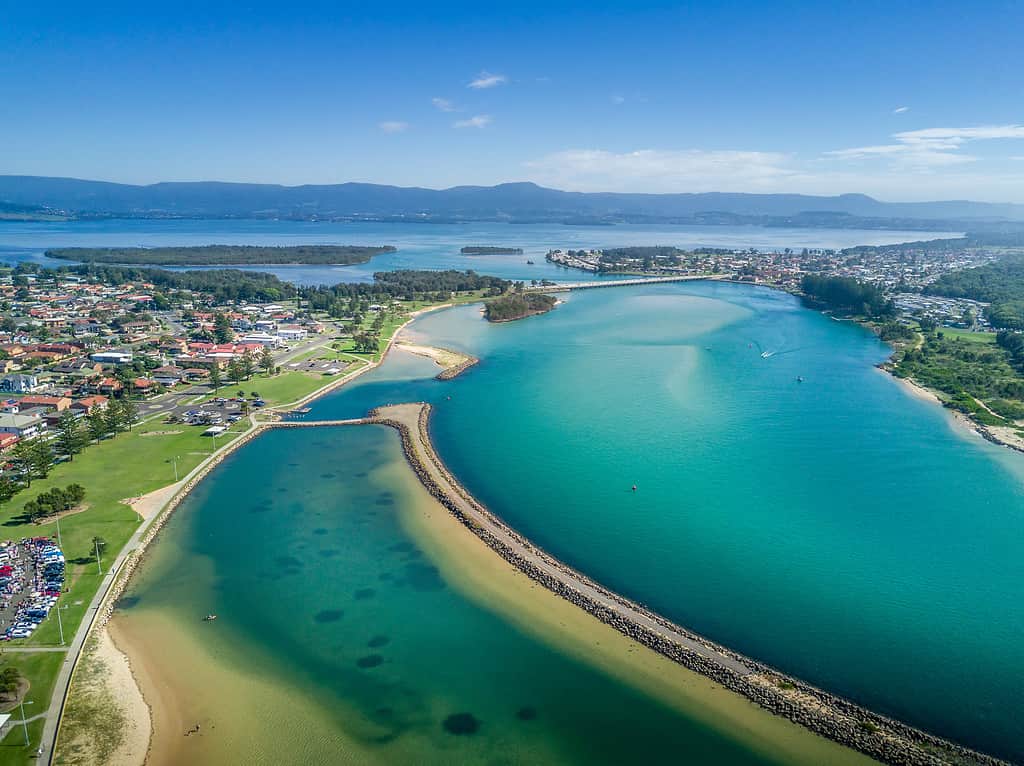
The many break walls of Lake Illawarra help channel water, stop erosion, and create safe areas for the public.
©lovleah/iStock via Getty Images
Lake Illawarra ranks on the same level as Durras Lake. It has an A when it comes to algae, but a B for water clarity and estuary health. Unlike Durras Lake, this is pretty much the par for Lake Illawarra. There have been a few bad years where the lake got C ratings or B ratings across the board, but it has never gone below a C.
The estuary that makes up Lake Illawarra is a vital habitat for many species, including the little tern. Interestingly, the name Illawarra is a name meaning “pleasant place near the sea.”
While it’s now a hotbed for tourists and water sports, it wasn’t always that way. The lake was originally owned by the Lake Illawarra Authority. They eventually turned the lake into an attraction for visitors.
Then, in 2014, a new group came in called the Lake Illawarra Estuary Management Committee. Their goal was to keep the area a place where people can visit and enjoy the water, but also keep the place safe for local flora and fauna, and respect the original land. There are a variety of different members in this group including community members, scientists, and Aboriginal representatives.
Lake Illawarra is a hotbed for recreational activities such as swimming, snorkeling, prawning, and sailing. You can find a lot of local birds as well, if you’re into birding such as musk ducks, pelicans, cormorants, and black swans. There’s a report of bull sharks being in the area as well.
7. Cuttagee Lake
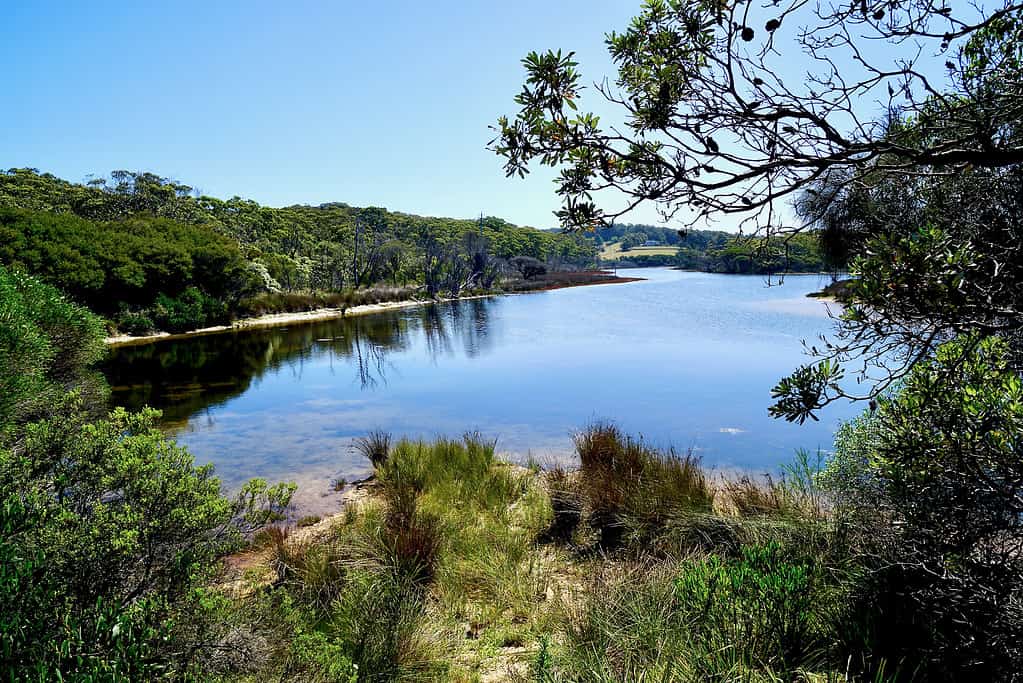
Known as Cuttagee Lake, this area is a beautiful spot and a perfect place to take the family.
©Chromatic Exposures/iStock via Getty Images
Cuttagee Lake has an overall B, or good ranking. The algae levels and overall estuary health are a B, while the water clarity is an A. This lake is an important breeding ground, nursery, and feeding ground for many fish and birds in the area.
The lake is also a great place for canoeing, kayaking, fishing, and prawning. This is an open area with little regulation. It’s not patrolled and there aren’t any amenities, which means you may need to bring a bag to take all of your trash back out with you.
There is also an off-leash area for your dogs nearby. If your dog loves water and you want to find a place to take them, then this is a great lake just for that. This is a fun area for families, as there’s a thick sand bar that is perfect for children and pets to explore and play in the water safely. The water is usually a little salty, so it mimics the beach perfectly, but with a lot less dangerous waves that can sweep up an unsuspecting child.
The lake is also surrounded by one of the famous single-lane wooden bridges of the Sapphire Coast if you want a place to explore when you’re done playing around in the water.
Though there usually isn’t a direct connection between the ocean and the lake unless it’s been raining heavily, the two are pretty close. Play around at the beach for a little bit and then go kayaking in the lake. There’s plenty to do to keep you busy for a full day, or even several days.
Table of the Cleanest Lakes in New South Wales
| Ranking | Lake Name | Location | Activities |
|---|---|---|---|
| 1 | Wallis Lake | Near Wallinat National Park | Boating, fishing, swimming, paddle boarding |
| 2 | Myall Lakes | In Myall Lakes National Park | Hiking, kayaking, fishing |
| 3 | Merimbula Lake | Near Merimbula | Paddle boarding, swimming, fishing, kayaking, boating |
| 4 | Burrill Lake | In Burrill Lake | Eating, swimming, fishing, water-skiing, canoeing, exploring, hiking |
| 5 | Durras Lake | Near Batemans Bay | Fishing, hiking, swimming, kayaking, crabbing |
| 6 | Lake Illawarra | Near Wollongong | Snorkeling, prawning, fishing, swimming, sailing, birding |
| 7 | Cuttagee Lake | South of Bermagui | Wading in the shallows, kayaking, fishing, and prawning |
The photo featured at the top of this post is © Jono Photography/Shutterstock.com
Thank you for reading! Have some feedback for us? Contact the AZ Animals editorial team.






